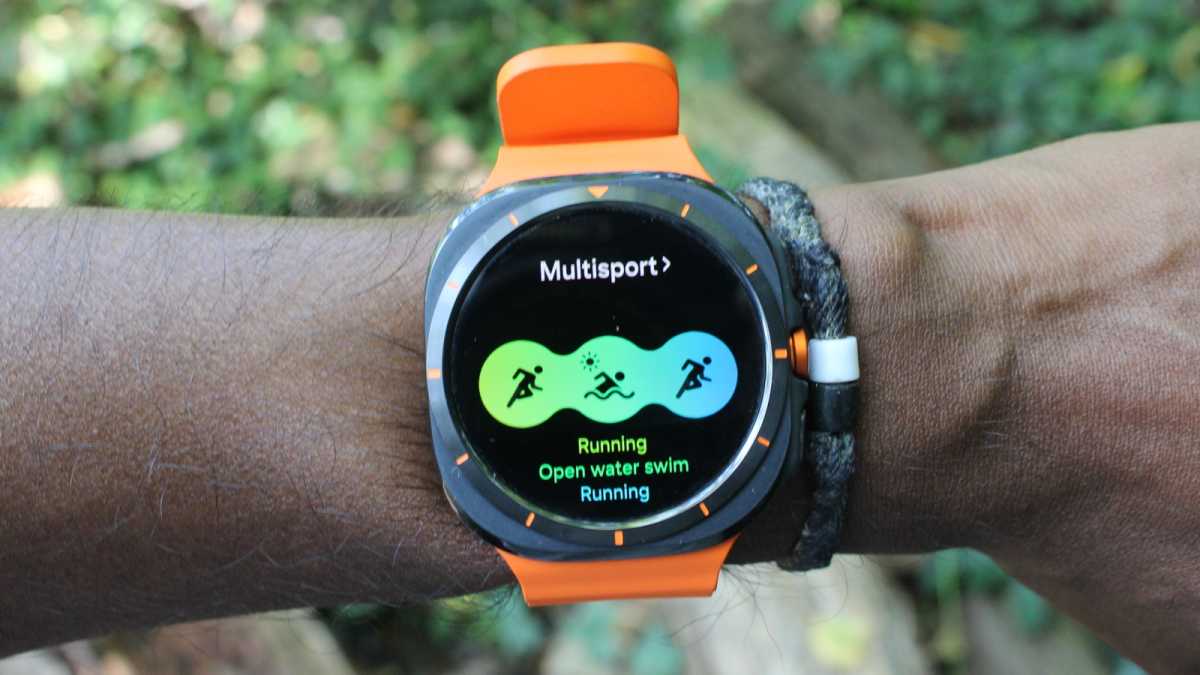Expert’s Rating
Pros
- Durable design
- Rich array of smartwatch and health features
- Big, bright AMOLED display
Cons
- Some GPS accuracy issues
- No offline mapping support
- Inconsistent battery performance
Our Verdict
The Galaxy Watch Ultra is one of Samsung’s nicest smartwatches that offers some good fitness and outdoor features but as far as being Android’s answer to the Apple Watch Ultra, it’s not quite there yet.
The Samsung Galaxy Watch Ultra is Samsung’s answer to the Apple Watch Ultra. A smartwatch built for the extreme outdoors and for fitness fans who don’t consider nailing daily step totals as the kind of accomplishment to shout about.
Like the new Galaxy Watch 7, the Ultra runs on Wear OS 5, the latest version of Google’s smartwatch operating system. It matches that new software with features like the latest GPS positioning technology, new specialist sports modes and includes safety features to make the Ultra the ideal smartwatch to have on for big hikes or tackling a triathlon.
The Galaxy Watch Ultra marks yet another new direction for Samsung’s smartwatch family, but was it the right one? Possibly.
Design & Build
- Just one case size option
- Quick button built into crown
- Samsung’s most durable smartwatch
There’s no getting away from the fact that the Galaxy Watch Ultra apes the look of the Apple Watch Ultra. Though it’s just about different enough though that you shouldn’t mistake one for the other.
You’re also not going to mistake it for the Samsung’s Galaxy Watch 7, which opts for a round case design as opposed to the larger, squarer chassis you get here on the Ultra.
the use of Grade 4 titanium ensures that while you’re getting a premium look you’re still getting something that doesn’t weigh heavy on your wrist
That square case with curved edges is wider and more square than Apple’s Ultra and measures in at 47mm, giving it the same case size as the largest Galaxy Watch 6 Classic.
This feels noticeably bigger compared to the Classic, though the use of Grade 4 titanium ensures that while you’re getting a premium look you’re still getting something that doesn’t weigh heavy on your wrist. Unlike the Galaxy Watch 7, the Ultra only comes in one case size and it’s still going to be a bit too much smartwatch for some with slender wrists, but I found it fine to wear in most scenarios with its hulking frame most noticeable when taking it to bed.
The strap options here do also scream Apple Watch Ultra. You’ve got your pick of Marine, Trail and PeakForm bands. I had one of the Marine ones to try, which is built for swims and has been a great fit for exercise. There’s a button-style lug system to let you clip them away from the watch case, which I do find one of the trickier button mechanisms to use, but it does mean you can switch things up here.
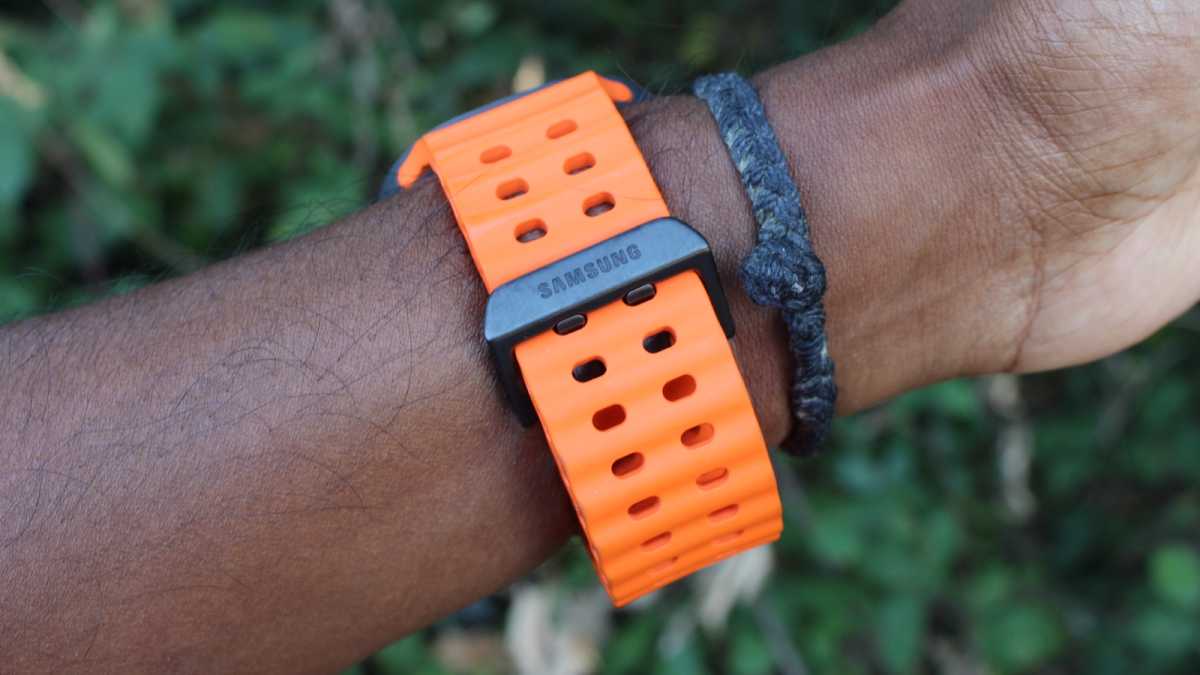
Mike Sawh
On the right side of the case you’ll find all three physical buttons available on the Ultra. There’s two flatter ones like the ones you’ll find on a Galaxy Watch and a crown-style one, which is what Samsung calls its Quick Button. This can be set up to give you quick access to the workout tracking screen, lock the watch when going for a swim or turn on the built-in torch mode.
You can also press this button for five seconds to launch a siren mode, which will emit an 86-decibel sound to help raise the alarm if you get lost going on a solo expedition. While it looks like a watch crown, it doesn’t act like one, which feels like a big missed opportunity.
Especially as the Ultra doesn’t include Samsung’s signature rotating bezel to offer an alternative way to scroll through menu screens. It means you’re left with the touchscreen which isn’t ideal in various situations the Ultra is designed for.
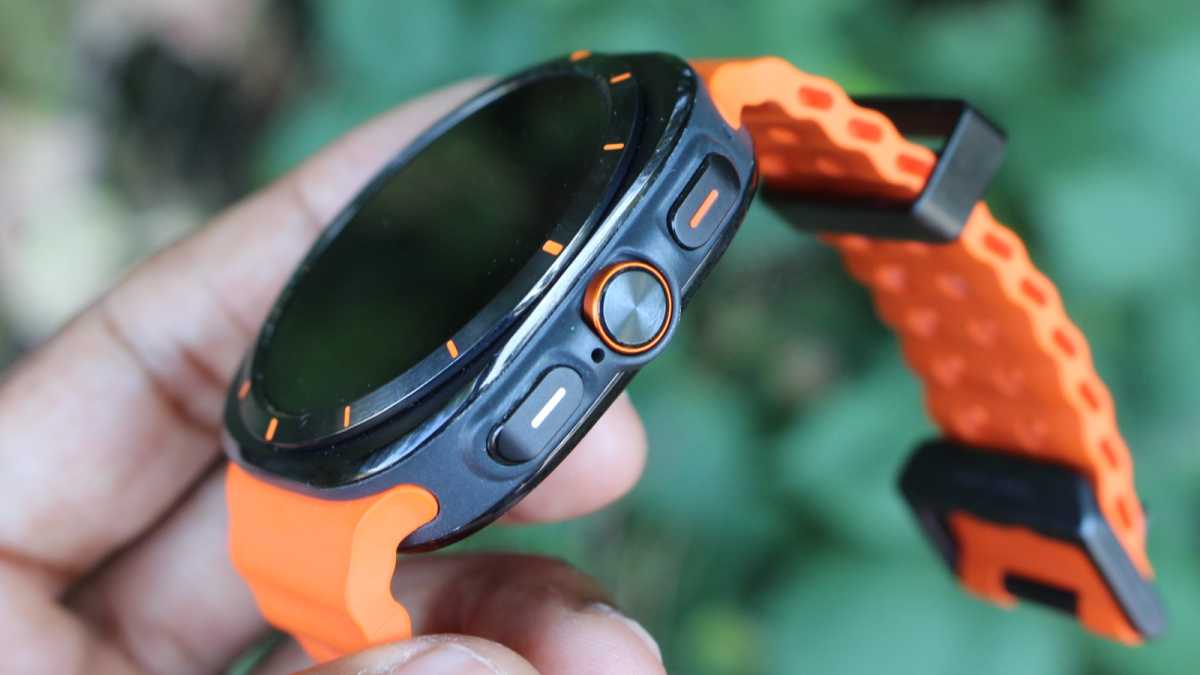
Mike Sawh
What Samsung does have here is a pretty tough watch. It’s been military standard tested for the ability to operate at extreme temperatures and to withstand shock and strong vibrations.
There’s sapphire crystal glass to offer the kind of protection against scratches you’d associate with premium watches and smartwatches. It’s got an IP68 dust resistance rating and an additional 10ATM waterproof rating of up to 100 metres depth making it Samsung’s most waterproof smartwatch yet. I’ve used the Ultra for open water swimming and I’m happy to say it has survived a good dunking outside of wearing it in an inside pool and keeping it on in the shower.
Samsung rarely disappoints on the display front and it’s no different with the Ultra’s screen
Screen & Audio
- Large, vibrant Super AMOLED screen
- Supports always-on mode
- Speaker and microphone for calls
Samsung rarely disappoints on the display front and it’s no different with the Ultra’s screen.
You’ve got a 1.5-inch, 480 x 480 resolution Super AMOLED touchscreen, so that’s the same size and shaped screen found on the 44mm edition of the Galaxy Watch 7.
It’s a display where colours really pop, it’s a very bright screen (up to 3000 nits, according to Samsung) and it’s a slick one to interact with. You do also have the choice to keep the screen on at all times or use the raise to wake, which has thankfully been nicely responsive to that gesture.
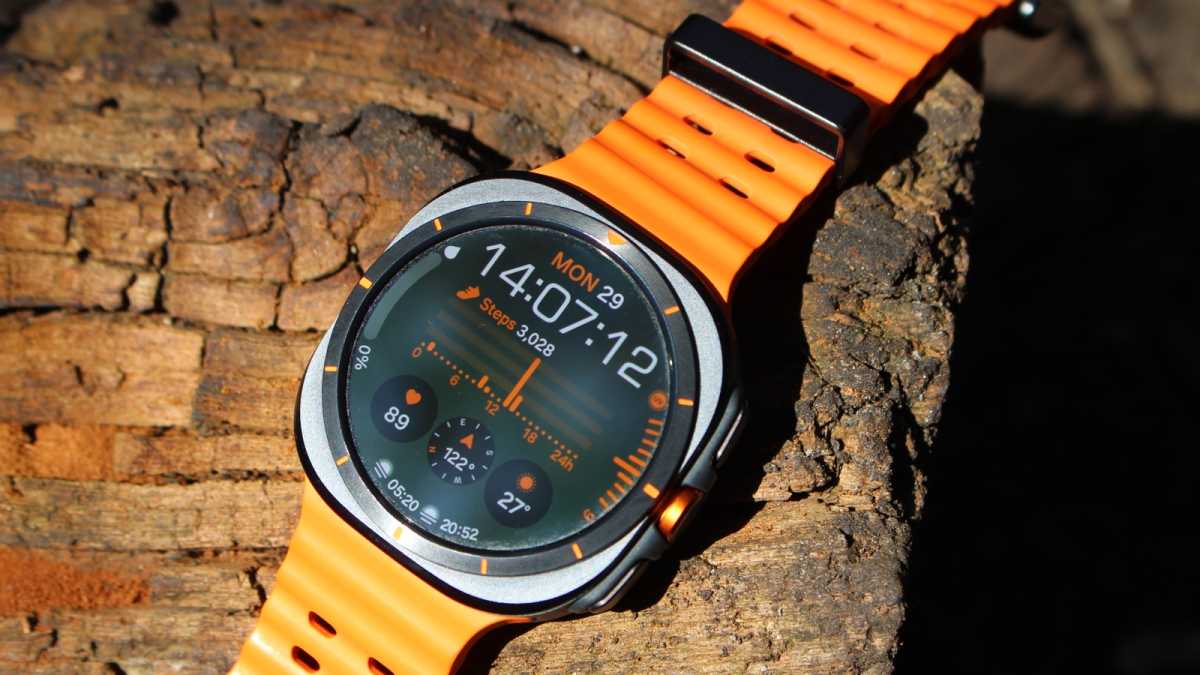
Mike Sawh
Like the Galaxy Watch 7, there is a speaker and microphone array to make use of the onboard LTE connectivity to take calls – there is no Bluetooth-only option, like the Apple Watch Ultra.
It also means you can hear answers to your queries when using Google Assistant or Samsung’s Bixby assistant. The microphone responsiveness has been very good in general and the speakers, while not exceptionally crisp do offer good volume and good enough clarity to make them suitable for those voice-based tasks.
Software & Features
- Runs on Wear OS 5.0
- AI-powered suggested replies
- Double pinch gesture
With the Ultra, you’re getting the latest that Samsung and Google has to offer right now in software.
You’ve also got Samsung’s new Exynos W1000 3nm processor set up to keep that software running smoothly. Performance hasn’t really been an issue for Samsung’s smartwatches in the past and it’s more of the same in terms of interacting with the Ultra. It’s slick and responsive.
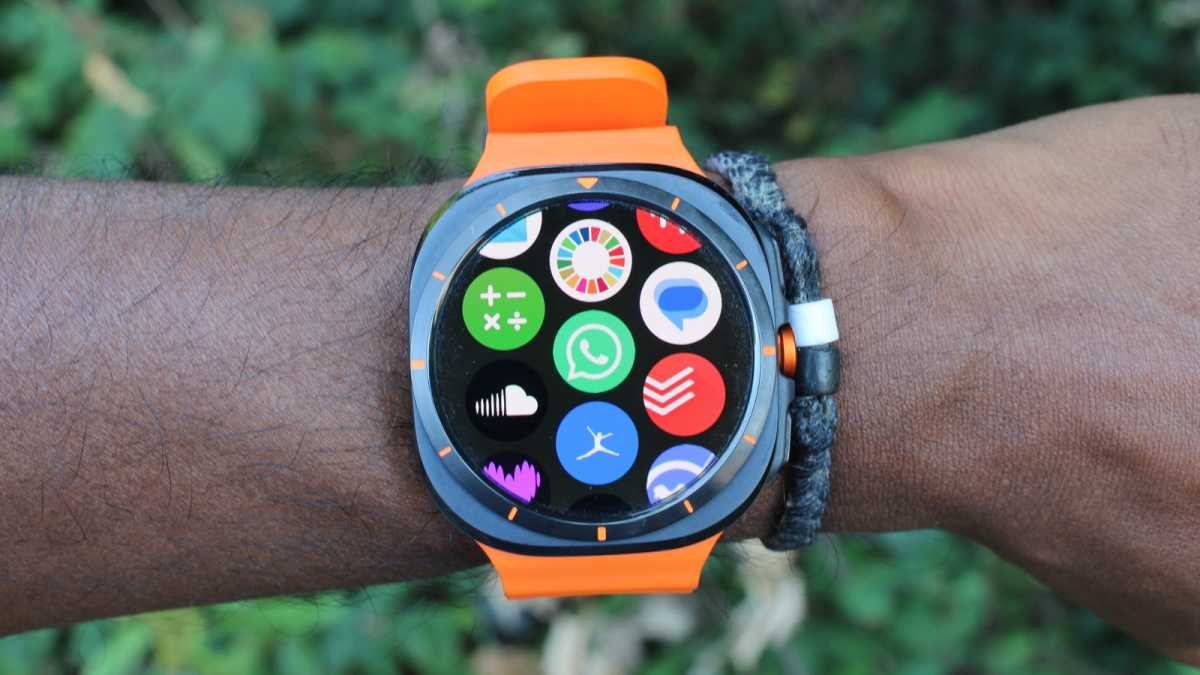
Mike Sawh
Where things can be slightly more mixed is with the software it’s powering. You’ve got Google’s Wear OS 5.0 with Samsung’s One UI 6 Watch overlaid on top. The latter tells you you’re using a Samsung smartwatch with Google’s presence mainly felt through the inclusion of apps like Google Play Store, Google Maps and Google Assistant.
In terms of what Wear OS 5.0 is bringing to the software party, it’s hard to say really. When Google announced the new version of Wear at Google I/O it felt very much like a Wear OS instalment that was more about boosting efficiency mainly, which isn’t something that’s massively been an issue for Samsung’s smartwatches.

Mike Sawh
With an added physical button and lack of a rotating bezel, it has meant navigating the watch software is a bit awkward. The two flatter physical buttons have pretty limited functionality and as mentioned, that crown button doesn’t rotate as I’d like it to be able to.
The addition of Samsung’s double pinch does at least add a useful new dimension. While it’s another Apple ripoff, it’s handy for doing things like dismissing alarms or using to take photos with a Galaxy smartphone.
What you can’t massively fault is the experience of using the Ultra as a smartwatch. You’re getting a rich level of notification support, including the now AI-fuelled suggested replies for messaging. The addition of Google’s Play Store means a better selection of apps at your disposal and you’ve got 32GB of storage to pile on apps and music for offline play as well.
Fitness & Tracking
- Dual-frequency GPS
- Multisport tracking mode
- Route and navigation features
I’ve always found Samsung’s approach to fitness, sports and health tracking mixed. It always felt like a better fitness tracker and health monitoring watch than the kind of watch that’s going to compete with sports watches from Garmin, Polar and a resurgent Suunto.
Samsung is really trying to change that by including features that it hopes will give the Ultra real appeal for serious athletes.

Mike Sawh
That’s led by features like dual-frequency GPS, a feature we’ve seen appear on sports watches and smartwatches to boost outdoor tracking accuracy when tracking near tall buildings or densely forested areas.
We’re now getting a mode to track multiple sports in one workout session, which is essentially bringing a dedicated triathlon mode to Samsung’s smartwatch for the first time.
Cyclists can generate personalised FTP (functional threshold power), though you need to pair the Samsung Health app to a power meter to make that work. You do also have the ability to upload routes to help you navigate your way on hikes, rides and runs.
I’d say the sports tracking experience with the Ultra isn’t too far off what I’ve experienced on previous Samsung smartwatches. It’s just not there with the best and I’m mainly talking about Apple and Garmin when I talk about the best. From an Android perspective, you could say Huawei offers a more polished sports tracking experience as well.
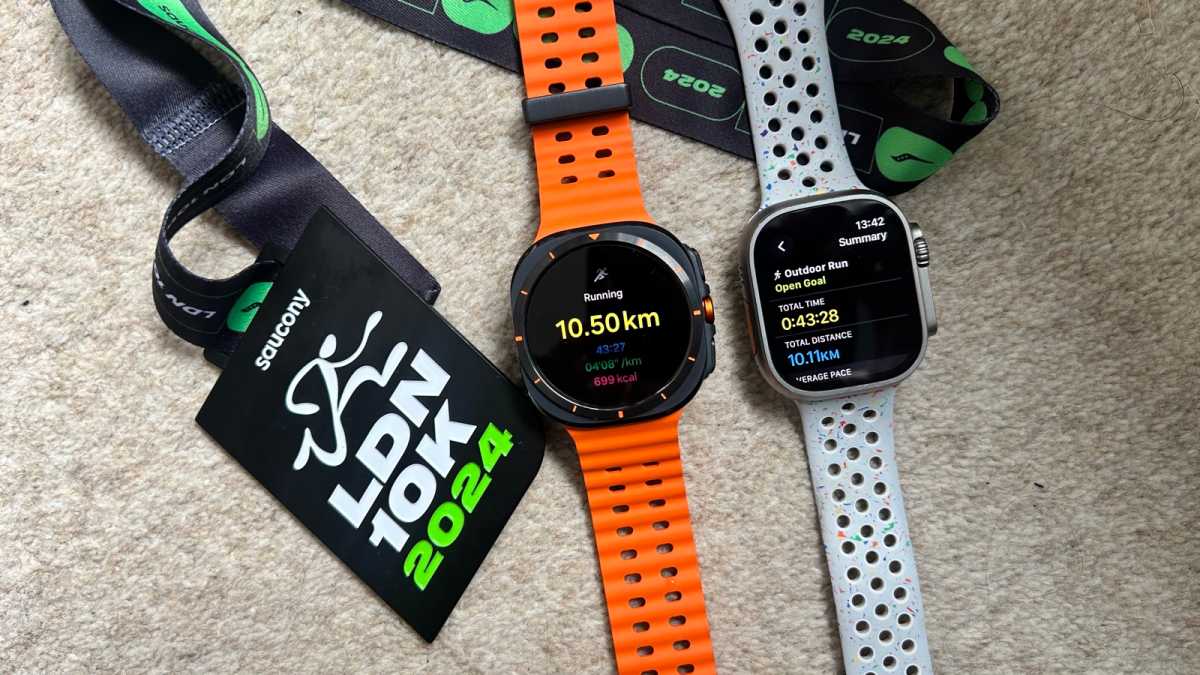
Mike Sawh
That promised improved GPS performance didn’t quite work out when I tested it at the Saucony London 10k. A race that takes place at the heart of London where there are plenty of tall buildings to wreak havoc on GPS. I used it alongside the Apple Watch Ultra 2 and Apple’s was much closer to the exact course distance than the Samsung watch, which was a fair bit out.
I took the Galaxy Watch Ultra for an open water swim with the Garmin Forerunner 965 and the Ultra registered no distance data whatsoever. It wasn’t a good show.

Mike Sawh
This sensor setup feels like a better fit for Samsung’s rich health tracking than sports tracking
The mapping and navigation features here don’t include the free offline maps you get on a Garmin, Polar and Suunto AMOLED sports watches or the Apple Watch Ultra. Instead, it’s more about importing routes from the Samsung Health app to the watch, that you can follow on the watch.
The experience of viewing routes and navigating works well enough, but as far as matching the mapping and navigation support you get from rival watches, that simply isn’t the case right now.
Samsung’s BioActive sensor pulls together optical tracking for heart rate, blood pressure, blood oxygen levels and there’s also ECG sensors and a body composition analysis mode to give you smart scale-style measurements. This sensor setup feels like a better fit for Samsung’s rich health tracking than sports tracking.
In that 10k race test against a heart rate monitor, average heart rate readings were 5bpm higher and maximum readings were 8bpm higher. You don’t have the option to pair an external heart rate monitor to remedy this once again. Samsung’s Energy Scores, which works much like Oura’s Readiness scores, offered useful guidance on when to rest up and take it easy on days and is a step in the right direction for Samsung.
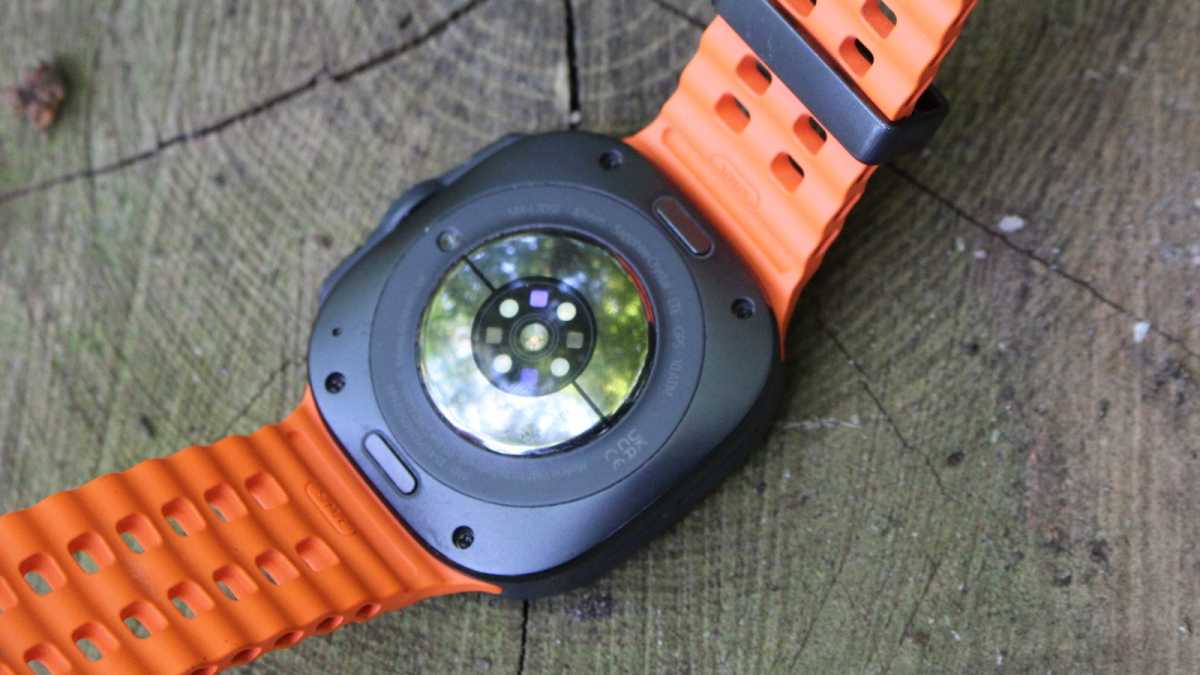
Mike Sawh
Overall then, the Galaxy Watch Ultra is an okay sports watch, a useful, motivating fitness tracker and like the Galaxy Watch, offers a great place to track your serious health but has it limitations and downsides.
Battery Life
- Lasts 2-3 days in smartwatch mode
- Up to 100 hours in power saving mode
- Up to 48 hours in exercise power saving mode
The Samsung Galaxy Watch Ultra packs in a 590mAh capacity battery, which is the same sized battery included inside of the Samsung’s Galaxy Watch 5 Pro.
Like Samsung’s other smartwatches, Samsung is reticent to state how long battery life in general should last on the Ultra, but is happy to state that it can last up to 100 hours with its onboard power-saving mode, which restricts the use of features such as connectivity, so reducing notification support for apps that need a data connection to push things further.
Samsung also refers to an exercise power saving mode, which you can turn on in the pre-workout tracking settings to lower the sampling frequency rate of heart rate and GPS as well as turning off Bluetooth and network connections to give you 48 hours battery life.
I found that on average it lasted 2 days and maxed out to just over 2 days

Mike Sawh
I used the Galaxy Watch Ultra with a mixture of keeping the screen always-on, using the raise to wake and making use of the power saving mode. I found that on average it lasted 2 days and maxed out to just over 2 days. It’s no surprise to find that using the display in always-on mode does noticeably drain the battery quicker and that’s when the Ultra had to work harder to get through a couple of days in between charges.
The power saving mode can push things slightly longer, though if you’re using the watch to track a workout during that time you need to use the exercise power saving mode, which makes the use of the modes slightly confusing. Forgetting to do that saw the battery run out for a 30-minute run using the most accurate GPS mode.
In terms of GPS battery life, I definitely saw some inconsistencies there with performance. On outdoor sessions of a similar duration, I saw different levels of drain in battery life. For a 10k race, the battery drop was over 10%. In another test, the battery drop was smaller.
Ultimately, you need to really tinker to get the best battery performance here, but much like the Apple Watch Ultra, I wish it was much more than a couple of days.
Price & Availability
The Samsung Galaxy Watch Ultra was officially unveiled at Samsung’s Unpacked event in July 2024 alongside the Galaxy Watch 7 and the Samsung Galaxy Ring. Unlike the Galaxy Watch 7, it’s only available in one case size and that comes with both Bluetooth and 4G LTE connectivity.
That model costs £599/$649.99 making it more expensive than the largest size Galaxy Watch 7 and cheaper than the Apple Watch Ultra 2.
You can buy it from Samsung as well as the likes of Amazon, John Lewis, Currys and Argos.
In the US, you can buy it from Samsung as well as Amazon and BestBuy.
It’s also more expensive than other rugged Wear OS smartwatches like the TicWatch Pro 5 Enduro. In terms of other Android-friendly smartwatches that sit in the same category as the Galaxy Watch Ultra, it’s cheaper than the AMOLED-packing Garmin Epix Gen 2 Pro.
Check out our best smartwatches chart for our top picks.
Should you buy the Samsung Galaxy Watch Ultra?
If you’re hoping for the Android to answer to the Apple Watch Ultra, then I wouldn’t say that was my experience. You’re absolutely getting a big, tough rugged watch with features that can make it a strong outdoor companion.
However, as far as ticking all the boxes for what you’d expect from a modern outdoor smartwatch, like offline mapping, accurate tracking and long battery life, you’re probably better off picking up something like the Garmin Epix Gen 2, which might not possess the same level of smartwatch and health tracking features, but does give you much more on the outdoor tracking front for less money.
This is a good start and is arguably the best Wear OS outdoor smartwatch, but this isn’t on par with the Apple Watch Ultra.
Specs
- 47mm case
- 10 ATM water resistance rating
- IP68 dust resistance rating
- 590mAh capacity battery
- 32GB storage
- Dual-frequency GPS
- Bluetooth and LTE connectivity
- ECG sensor
- Optical blood pressure and heart rate tracking






